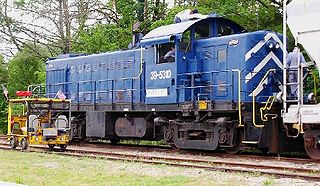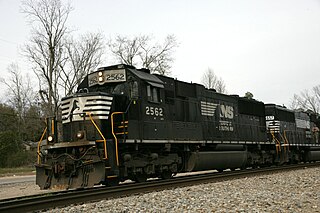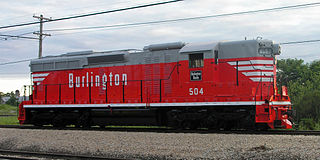
The SD80MAC was a 5,000 horsepower (3.7 MW) C-C diesel-electric locomotive. It was powered by a 20-cylinder version of EMD's 710G prime mover, and was the second diesel locomotive by GM-EMD to use a v20 engine, since EMD's SD45 and SD45-2. It introduced a wide radiator housing similar to GE Transportation locomotives and the placement of dynamic brakes at the rear of the locomotive, which is a quieter location, features that were incorporated into the SD90MAC and SD70ACe models. Key spotting differences between the SD80MAC and SD90MAC include no external rear sandbox on the SD90MAC, rear number boards, and the placement of the front numberboards. The SD80MAC also had recessed red marker lights in the nose, an identifying feature unique to Conrail (CR) locomotives, although Norfolk Southern (NS) had removed the lights on most of their former Conrail engines.

Montreal Locomotive Works (MLW) was a Canadian railway locomotive manufacturer which existed under several names from 1883 to 1985, producing both steam and diesel locomotives. For a number of years it was a subsidiary of the American Locomotive Company. MLW's headquarters and manufacturing facilities were located in Montreal, Quebec.

The EMD DDA40X is a 6,600 hp (4,943 kW) D-D locomotive, built by EMD from 1969 to 1971 exclusively for the Union Pacific Railroad. It is the most powerful diesel-electric locomotive model ever built on a single frame, having two 16-645E3A diesel prime movers. Union Pacific has marked DD40X on the cab exteriors, while EMD literature inconsistently refers to this model as either DD-40X or DDA40X.

A hood unit, in North American railroad terminology, is a body style for diesel and electric locomotives where the body is less than full-width for most of its length and walkways are on the outside. In contrast, a cab unit has a full-width carbody for the length of the locomotive and walkways inside. A hood unit has sufficient visibility to be operated in both directions from a single cab. Also, the locomotive frame is the main load-bearing member, allowing the hood to be non-structural and easily opened or even removed for maintenance.

A road switcher is a type of railroad locomotive designed to both haul railcars in mainline service and shunt them in railroad yards. Both type and term are North American in origin, although similar types have been used elsewhere.

The EMD SD70 is a series of diesel-electric locomotives produced by the US company Electro-Motive Diesel in response to the GE Dash 9-44CW. Production commenced in late 1992 and since then over 5,700 units have been produced; most of these are the SD70M and SD70MAC models. While the majority of the production was ordered for use in North America, various models of the series have been used worldwide. All locomotives of this series are hood units with C-C trucks, except the SD70ACe-P4 which has a B1-1B wheel configuration, and the SD70ACe-BB, which has a B-B-B-B wheel arrangement.

The EMD SD90MAC is a model of 6,000 hp (4,470 kW) C-C diesel-electric locomotive produced by General Motors Electro-Motive Division. It is, with the SD80MAC, one of the largest single-engined locomotives produced by EMD, surpassed only by the dual-engined DDA40X.

The EMD SD40-2 is a 3,000-horsepower (2,200 kW) C-C diesel-electric locomotive built by EMD from 1972 to 1989.

The EMD DD35A, also known as the EMD DDA35, was a 5,000 hp (3,730 kW) diesel-electric locomotive of D-D wheel arrangement built by General Motors Electro-Motive Division exclusively for the Union Pacific Railroad. They were a cab-equipped variant of the previous, cabless booster EMD DD35. Fifteen DD35A locomotives were built between May and July 1965; they were assigned road numbers 70 through 84. This request also led to the introduction of the ALCO Century 855 and GE U50. A further development of the 8 axle, twin-engined locomotive produced the final, best known type, the DDA40X "Centennial".

The EMD Dash 2 is a line of diesel-electric locomotives introduced by General Motors' Electro-Motive Division (EMD) on January 1, 1972. Designations of these models were those of the former models with "-2" added. They retained the basic specifications of the earlier models in terms of power output and most other features, but introduced a number of improvements to the locomotives' internal systems, specifically the electrical systems and the trucks of the locomotives. These were intended to improve availability, efficiency, and ease of maintenance.

The EMD SD24 was a 2,400 hp (1,800 kW) six-axle (C-C) diesel-electric locomotive built by General Motors' Electro-Motive Division of La Grange, Illinois between July 1958 and March 1963. A total of 224 units were built for customers in the United States, comprising 179 regular, cab-equipped locomotives and 45 cabless B units. The latter were built solely for the Union Pacific Railroad.

The EMD SD60 is a 3,800 horsepower (2,800 kW), six-axle diesel-electric locomotive built by General Motors Electro-Motive Division, intended for heavy-duty drag freight or medium-speed freight service. It was introduced in 1984, and production ran until 1995.

The EMD GP7 is a four-axle (B-B) diesel-electric locomotive built by General Motors Electro-Motive Division and General Motors Diesel between October 1949 and May 1954.

The EMD GP38-2 is an American four-axle diesel-electric locomotive built by General Motors, Electro-Motive Division. Part of the EMD Dash 2 line, the GP38-2 was an upgraded version of the earlier GP38. Power is provided by an EMD 645E 16-cylinder engine, which generates 2,000 horsepower.

An SDP40 is a 6-axle passenger diesel-electric locomotive built by General Motors Electro-Motive Division (EMD) between June 1966 and May 1970.

An EMD GP60 is a 4-axle (B-B) diesel-electric locomotive built by General Motors Electro-Motive Division between 1985 and 1994. The GP60 was EMD's first engine that was classified as a "third-generation" locomotive. Hidden behind the electrical cabinet doors on the rear wall of the cab, the GP60 concealed a trio of microprocessors that monitored and managed a host of engine, cooling system and control functions. The engine's on-board microprocessors replaced hundreds of wiring circuits, dozens of relays and all but one module card, making it an improvement among EMD's engines.

The long hood of a hood unit-style diesel locomotive is, as the name implies, the longer of the two hoods on a locomotive, particularly American-type freight locomotives.

Southern Pacific 9010 is a KM ML 4000 C'C' diesel-hydraulic locomotive, built in 1964 by German manufacturer Krauss-Maffei for the Southern Pacific Railroad. SP 9010 generated 4,000 horsepower (3,000 kW) from two 2,000 horsepower (1,500 kW) V16 Maybach MD870 diesel engines. It was painted to Southern Pacific's 1958 standard, the so-called "bloody nose" colors of Scarlet and Lark Dark Gray, for its entire operating career. It was renumbered to SP 9113 in late 1965, rebuilt extensively at SP's Sacramento General Shops during the latter half of 1966, and was initially retired in 1968. It was revived and rebuilt by Sacramento General Shops into a "camera car" for the purpose of shooting motion picture background plates for a ground-based full-motion locomotive training simulator. As camera car number 8799, it was retired in 1984 and donated to the California State Railroad Museum in Sacramento, California. It was de-accessioned by CSRM and acquired by the Pacific Locomotive Association and moved to the Niles Canyon Railway's Brightside, California rail yard in the summer of 2008. At the date of its inception, its type represented the highest-horsepower six-axle diesel locomotives in the world. SP 9010 is the sole surviving ML 4000 C'C' built for use in North America, and the sole surviving mainline diesel-hydraulic locomotive in North America.

A B unit, in railroad terminology, is a locomotive unit which does not have a control cab or crew compartment, and must therefore be operated in tandem with another coupled locomotive with a cab. The terms booster unit and cabless are also used. The concept is largely confined to North America. Elsewhere, locomotives without driving cabs are rare.

The EMD SD30C-ECO is a 3,000-horsepower (2,200 kW) C-C diesel-electric locomotive built by EMD. Although similar to the EMD SD32ECO, the SD30C-ECO follows the Canadian Pacific Railway's request for crashworthiness and EPA emission standards with the "C" in the designation denoting crashworthiness of the cab, frame, and fuel tank. CP requested relaxed emission standards to cut costs.






















